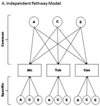Genetic etiology of the common liability to drug dependence: evidence of common and specific mechanisms for DSM-IV dependence symptoms
- PMID: 22243758
- PMCID: PMC3342475
- DOI: 10.1016/j.drugalcdep.2011.12.015
Genetic etiology of the common liability to drug dependence: evidence of common and specific mechanisms for DSM-IV dependence symptoms
Abstract
Background: We investigated the etiological nature of comorbid alcohol, tobacco, and cannabis DSM-IV dependence symptoms in late adolescence and young adulthood while accounting for gender differences in the magnitude of genetic and environmental influences.
Methods: Univariate and multivariate twin modeling was used to determine the heritability of each substance and the etiology of multiple drug problems in a sample of 2484 registrants of the Center for Antisocial Drug Dependence who provided data at the second wave of an ongoing longitudinal study. We report on mean and prevalence levels of whole-life DSM-IV dependence symptoms that were assessed with the Composite International Diagnostic Interview-Substance Abuse Module. Biometrical analyses were limited to age-adjusted DSM-IV dependence symptom counts from a subset of twins that reported using alcohol, tobacco, or cannabis in their lifetime.
Results: Male and female alcohol, tobacco, and cannabis DSM-IV symptoms are indicators of a heritable unidimensional latent continuous trait. Additive genetic factors explain more than 60% of the common liability to drug dependence. A larger proportion of the variation in each substance is attributable to substance-specific genetic and environmental factors.
Conclusions: These data suggest that both common and substance-specific genetic and environmental factors contribute to individual differences in the levels of DSM-IV alcohol, tobacco, and cannabis dependence symptoms.
Copyright © 2012 Elsevier Ireland Ltd. All rights reserved.
Conflict of interest statement
All of the listed authors declare that they have no conflicts of interests.
Figures


Similar articles
-
Examining the role of common genetic variants on alcohol, tobacco, cannabis and illicit drug dependence: genetics of vulnerability to drug dependence.Addiction. 2015 Mar;110(3):530-7. doi: 10.1111/add.12815. Epub 2015 Jan 20. Addiction. 2015. PMID: 25424661 Free PMC article.
-
Initial reactions to tobacco and cannabis smoking: a twin study.Addiction. 2014 Apr;109(4):663-71. doi: 10.1111/add.12449. Epub 2014 Jan 23. Addiction. 2014. PMID: 24325652 Free PMC article.
-
Stability and change of genetic and environmental effects on the common liability to alcohol, tobacco, and cannabis DSM-IV dependence symptoms.Behav Genet. 2013 Sep;43(5):374-85. doi: 10.1007/s10519-013-9599-5. Epub 2013 Jun 13. Behav Genet. 2013. PMID: 23760788 Free PMC article.
-
The genetic epidemiology of cannabis use, abuse and dependence.Addiction. 2006 Jun;101(6):801-12. doi: 10.1111/j.1360-0443.2006.01399.x. Addiction. 2006. PMID: 16696624 Review.
-
The Harvard Twin Study of Substance Abuse: what we have learned.Harv Rev Psychiatry. 2001 Nov-Dec;9(6):267-79. Harv Rev Psychiatry. 2001. PMID: 11600486 Review.
Cited by
-
The Etiologic, Theory-Based, Ontogenetic Hierarchical Framework of Alcohol Use Disorder: A Translational Systematic Review of Reviews.Psychol Bull. 2021 Oct;147(10):1075-1123. doi: 10.1037/bul0000333. Psychol Bull. 2021. PMID: 35295672 Free PMC article.
-
Shared additive genetic influences on DSM-IV criteria for alcohol dependence in subjects of European ancestry.Addiction. 2015 Dec;110(12):1922-31. doi: 10.1111/add.13070. Epub 2015 Aug 22. Addiction. 2015. PMID: 26211938 Free PMC article.
-
Individual Differences in Substance Use Motives, Trauma, and Stress Among College-Based Polysubstance Users.Subst Use Misuse. 2024;59(8):1228-1239. doi: 10.1080/10826084.2024.2330911. Epub 2024 Mar 27. Subst Use Misuse. 2024. PMID: 38544304 Free PMC article.
-
The Concept of Resistance to Substance Use and a Research Approach: The Resist! Project.Twin Res Hum Genet. 2023 Feb;26(1):31-39. doi: 10.1017/thg.2023.8. Epub 2023 Mar 10. Twin Res Hum Genet. 2023. PMID: 36896815 Free PMC article.
-
Mpdz expression in the caudolateral substantia nigra pars reticulata is crucially involved in alcohol withdrawal.Genes Brain Behav. 2014 Nov;13(8):769-76. doi: 10.1111/gbb.12171. Epub 2014 Sep 17. Genes Brain Behav. 2014. PMID: 25109596 Free PMC article.
References
-
- Agrawal A, Lynskey MT. Are there genetic influences on addiction: evidence from family, adoption and twin studies. Addiction. 2008;103:1069–1081. - PubMed
-
- Akaike H. Factor analysis and AIC. Psychometrika. 1987;52:317–332.
-
- American Psychiatric Association. Statistical Manual of Mental Disorders. 4th edition. Washington, DC: American Psychiatric Association; 1994.
-
- Chen JC, Chen PC, Chiang YC. Molecular mechanisms of psychostimulant addiction. Chang Gung Med. J. 2009;32:148–154. - PubMed
Publication types
MeSH terms
Grants and funding
- T32 MH019927/MH/NIMH NIH HHS/United States
- DA021913/DA/NIDA NIH HHS/United States
- K01 AA021113/AA/NIAAA NIH HHS/United States
- R01 DA021913/DA/NIDA NIH HHS/United States
- L30 DA032090/DA/NIDA NIH HHS/United States
- T32 AA007464/AA/NIAAA NIH HHS/United States
- MH063207/MH/NIMH NIH HHS/United States
- DA011015/DA/NIDA NIH HHS/United States
- HD010333/HD/NICHD NIH HHS/United States
- R56 MH063207/MH/NIMH NIH HHS/United States
- T32 MH016880/MH/NIMH NIH HHS/United States
- HD 010333/HD/NICHD NIH HHS/United States
- P60 DA011015/DA/NIDA NIH HHS/United States
- MH016880/MH/NIMH NIH HHS/United States
- AA007464/AA/NIAAA NIH HHS/United States
- MH019927/MH/NIMH NIH HHS/United States
- R01 MH063207/MH/NIMH NIH HHS/United States
- R01 HD010333/HD/NICHD NIH HHS/United States
LinkOut - more resources
Full Text Sources
Medical

